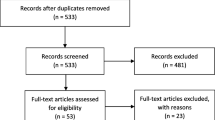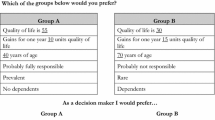Abstract
We used a discrete-choice conjoint experiment to model the mental health services preferences of patients of a federally-qualified health center serving a primarily low-income, Hispanic farmworker population in southwestern Arizona. The two attributes that had the largest influence on patient choices (i.e., received the highest importance scores) were where patients receive these services and the language and cultural awareness of the provider who prescribed their treatment. Simulations indicated that the clinic could substantially improve its patients’ welfare with even a single change. The single most effective change in terms of patient preferences would be to offer behavioral health services onsite.

Similar content being viewed by others
References
Allen, L. A., Escobar, J. I., Lehrer, P. M., Gara, M. A., & Woolfolk, R. L. (2002). Psychosocial treatments for multiple unexplained physical symptoms: A review of the literature. Psychosomatic Medicine, 64(6), 939–950.
Allenby, G. M, Arora, N., & Ginter, J. L. (1995). Incorporating prior knowledge into the analysis of conjoint studies. Journal of Marketing Research, 32(2), 152–162.
Allenby, G., Fennell, G., Huber, J., Eagle, T., Gilbride, T., Horsky, D., & Ofek, E. (2005). Adjusting choice models to better predict market behavior. Marketing Letters, 16(3–4), 197–208.
Arcury, T. A., & Quandt, S. A. (2007). Delivery of health services to migrant and seasonal farmworkers. The Annual Review of Public Health, 28, 345–363.
Bao, Y., Casalino, L. P., & Pincus, H. A. (2013). Behavioral health and health care reform models: Patient-centered medical home, health home, and accountable care organization. The Journal of Behavioral Health Services & Research, 40(1), 121–132. doi:10.1007/s11414-012-9306-y.
Borowsky, S. J., Rubenstein, L. V., Meredith, L. S., Camp, P., Jackson-Triche, M., & Wells, K. B. (2000). Who is at risk of nondetection of mental health problems in primary care? Journal of General Internal Medicine, 15(6), 381–388.
Bridges, J. F. (2003). Stated preference methods in health care evaluation: An emerging methodological paradigm in health economics. Applied Health Economics and Health Policy, 2(4), 213–224.
Bridges, J. F. P., Hauber, A. B., Marshall, D., Lloyd, A., Prosser, L. A., Regier, D. A., & Mauskopf, J. (2011). Conjoint analysis applications in health—a checklist: A report of the ISPOR good research practices for conjoint analysis task force. Value in Health, 14(4), 403–413.
Bridges, J., Onukwugha, E., Johnson, F. R., & Hauber, A. B. (2007). Patient preference methods—a patient centered evaluation paradigm. ISPOR Connections, 13(6), 4–7.
Caldwell, A., Couture, A., & Nowotny, H. (2008). Closing the mental health gap: Eliminating disparities in treatment for latinos. Kansas City, MO: Mattie Rhodes Center.
Callahan, E. J., Bertakis, K. D., Azari, R., Robbins, J. A., Helms, L. J., & Leigh, J. P. (2002). Association of higher costs with symptoms and diagnosis of depression. Journal of Family Practice, 51(6), 540–545.
Caruso, E. M., Rahnev, D. A., & Banaji, M. R. (2009). Using conjoint analysis to detect discrimination: Revealing covert preferences from overt choices. Social Cognition, 27(1), 128–137.
Carvajal, S. C., Rosales, C., Rubio-Goldsmith, R., Sabo, S., Ingram, M., McClelland, D. J., & O’Leary, A. O. (2013). The border community and immigration stress scale: A preliminary examination of a community responsive measure in two southwest samples. Journal of Immigrant and Minority Health, 15(2), 427–436.
Coyne, J. C., Thompson, R., Palmer, S. C., Kagee, A., & Maunsell, E. (2000). Should we screen for depression? Caveats and potential pitfalls. Applied and Preventive Psychology, 9(2), 101–121.
Cunningham, C. E., Deal, K., Rimas, H., Campbell, H., Russell, A., Henderson, J., & Melnick, B. (2008). Using conjoint analysis to model the preferences of different patient segments for attributes of patient-centered care. The Patient: Patient-Centered Outcomes Research, 1(4), 317–330.
Cunningham, C. E., Deal, K., Rimas, H., Chen, Y., Buchanan, D. H., & Sdao-Jarvie, K. (2009). Providing information to parents of children with mental health problems: A discrete choice conjoint analysis of professional preferences. Journal of Abnormal Child Psychology, 37(8), 1089–1102.
Dickinson, W. Perry., & Miller, B. F. (2010). Comprehensiveness and continuity of care and the inseparability of mental and behavioral health from the patient-centered medical home. Families, Systems, & Health, 28(4), 348–355. doi:10.1037/a0021866.
Dwight-Johnson, M., Lagomasino, I. T., Aisenberg, E., & Hay, J. (2004). Using conjoint analysis to assess depression treatment preferences among low-income Latinos. Psychiatric Services, 55(8), 934–936.
Escobar, J. I., Waitzkin, H., Silver, R. C., Gara, M., & Holman, A. (1998). Abridged somatization: A study in primary care. Psychosomatic Medicine, 60(4), 466–472.
Fraenkel, L., Gulanski, B., & Wittink, D. (2006). Patient treatment preferences for osteoporosis. Arthritis Care & Research, 55(5), 729–735.
General, S. (2001). Mental health: Culture, race, ethnicity, supplement to mental health: Report of the surgeon general. Washington, DC: US Department of Health and Human Services.
Hedrick, S. C., Chaney, E. F., Felker, B., Liu, C.-F., Hasenberg, N., Heagerty, P., & Paden, G. (2003). Effectiveness of collaborative care depression treatment in Veterans’ Affairs primary care. Journal of General Internal Medicine, 18(1), 9–16.
Hovey, J. D., & Seligman, L. D. (2006). The mental health of agricultural workers. In J. E. Lessenger (Ed.), Agricultural Medicine(pp. 282–299). New York: Springer.
Hsee, C. K., Loewenstein, G. F., Blount, S., & Bazerman, M. H. (1999). Preference reversals between joint and separate evaluations of options: A review and theoretical analysis. Psychological Bulletin, 125(5), 576.
Huber, J., Orme, B. K., & Miller, R. (2007). Dealing with product similarity in conjoint simulations. In A. Gustafsson, A. Herrmann, & F. Huber (Eds.), Conjoint measurement: Methods and applications (4th ed., pp. 347–362). New York: Springer.
Hui, M. K, & Bateson, J. E. G. (1991). Perceived control and the effects of crowding and consumer choice on the service experience. Journal of Consumer Research, 18(2), 174–184.
Ingram, M., Murrietta, L., Gall, A. J., Herman, P. M., De Zapien, J. G., & Carvajal, S. C. (2015). CHWs as focus group facilitators: A participatory action research method to improve behavioral health services for farmworkers in a primary care setting. Action Research Journal 13(1), 48–64.
Ingram, M., Schachter, K. A., Guernsey de Zapien, J., Herman, P. M., & Carvajal, S. C. (2014). Using participatory methods to enhance patient‐centred mental health care in a federally qualified community health center serving a Mexican American farmworker community. Health Expectations. doi:10.1111/hex.12284.
Katon, W. (1995). Will improving detection of depression in primary care lead to improved depressive outcomes? General Hospital Psychiatry, 17(1), 1–2.
Katon, W. J., Roy-Byrne, P., Russo, J., & Cowley, D. (2002). Cost-effectiveness and cost offset of a collaborative care intervention for primary care patients with panic disorder. Archives of General Psychiatry, 59(12), 1098–1104.
Kessler, R., & Stafford, D. (2008). Primary care is the de facto mental health system. New York: Springer.
Koizumi, N., Rothbard, A. B., & Kuno, E. (2009). Distance matters in choice of mental health program: Policy implications for reducing racial disparities in public mental health care. Administration and Policy in Mental Health and Mental Health Services Research, 36(6), 424–431.
Lancsar, E., & Louviere, J. (2008). Conducting discrete choice experiments to inform healthcare decision making. Pharmacoeconomics, 26(8), 661–677.
Lenk, P. J., DeSarbo, W. S., Green, P. E., & Young, M. R. (1996). Hierarchical Bayes conjoint analysis: Recovery of partworth heterogeneity from reduced experimental designs. Marketing Science, 15(2), 173–191.
Marshall, D., Bridges, J. F., Hauber, B., Cameron, R., Donnalley, L., Fyie, K., & Johnson, F. R. (2010). Conjoint analysis applications in health—how are studies being designed and reported? The Patient: Patient-Centered Outcomes Research, 3(4), 249–256.
Miranda, J., & Cooper, L. A. (2004). Disparities in care for depression among primary care patients. Journal of General Internal Medicine, 19(2), 120–126.
Orme, B. K. (2009). SSI web V6.6 software for web interviewing and conjoint analysis. Sequim: Sawtooth Software.
Orme, B. K. (2010). Getting started with conjoint analysis: Strategies for product design and pricing research (2nd ed.). Madison, WI: Research Publishers.
Orme, B., & Huber, J. (2000). Improving the value of conjoint simulations. Marketing Research, 12(4), 12–20.
Payne, J., Bettman, J., & Johnson, E. (1993). The adaptive decision maker. Cambridge, MA: Cambridge University Press.
Phillips, K. A., Johnson, F. R., & Maddala, T. (2002). Measuring what people value: A comparison of “attitude” and “preference” surveys. Health Services Research, 37(6), 1659–1679.
Raine, R., Haines, A., Sensky, T., Hutchings, A., Larkin, K., & Black, N. (2002). Systematic review of mental health interventions for patients with common somatic symptoms: Can research evidence from secondary care be extrapolated to primary care? BMJ, 325(7372), 1082.
Regier, D. A., Narrow, W. E., Rae, D. S., Manderscheid, R. W., Locke, B. Z., & Goodwin, F. K. (1993). The de facto US mental and addictive disorders service system: Epidemiologic catchment area prospective 1-year prevalence rates of disorders and services. Archives of General Psychiatry, 50(2), 85–94.
Renzaho, A. M. N., Romios, P., Crock, C., & Sønderlund, A. L. (2013). The effectiveness of cultural competence programs in ethnic minority patient-centered health care—a systematic review of the literature. International Journal for Quality in Health Care, 25(3), 261–269. doi:10.1093/intqhc/mzt006.
Rios-Ellis, B. (2005). Critical disparities in Latino mental health: Transforming research into action. White Paper. Washington, DC: Institute for Hispanic Health, National Council of La Raza.
Rosenthal, E. L., Wiggins, N., Ingram, M., Mayfield-Johnson, S., & De Zapien, J. G. (2011). Community health workers then and now: An overview of national studies aimed at defining the field. Journal of Ambulatory Care Management, 34, 247–259.
Rost, K., Pyne, J. M., Dickinson, L. M., & LoSasso, A. T. (2005). Cost-effectiveness of enhancing primary care depression management on an ongoing basis. The Annals of Family Medicine, 3(1), 7–14.
Ryan, M., & Farrar, S. (2000). Using conjoint analysis to elicit preferences for health care. British Medical Journal, 320(7248), 1530.
Ryan, M., Scott, D. A., Reeves, C., Bate, A., Van Teijlingen, E. R., Russell, E. M., & Robb, C. M. (2001). Eliciting public preferences for healthcare: A systematic review of techniques. Health Technology Assessment , 5(5), 1–186.
Sawtooth Software, Inc. (2009). The CBC/HB system for hierarchical Bayes estimation version 5.0 technical paper Sawtooth Software Technical Paper Series 1–31. Sequim, WA.
Sawtooth Software. CBC/Web Tutorial and Example. Retrieved March 10, 2015. http://www.sawtoothsoftware.com/download/techpap/cbcwebtut.pdf.
Scholle, S. H., Haskett, R. F., Hanusa, B. H., Pincus, H. A., & Kupfer, D. J. (2003). Addressing depression in obstetrics/gynecology practice. General Hospital Psychiatry, 25(2), 83–90.
Shah, A. K., & Oppenheimer, D. M. (2008). Heuristics made easy: An effort-reduction framework. Psychological Bulletin, 134(2), 207.
Smith, G. R., Rost, K., & Kashner, T. M. (1995). A trial of the effect of a standardized psychiatric consultation on health outcomes and costs in somatizing patients. Archives of General Psychiatry, 52(3), 238–243.
Software, S. (2008). The CBC advanced design module technical paper sawtooth software technical paper series 1-31. Sequim, WA: Sawtooth Software Inc.
Sorel, E., & Everett, A. (2011). Psychiatry and primary care integration: Challenges and opportunities. International Review of Psychiatry, 23(1), 28–30. doi:10.3109/09540261.2010.549117.
Van Berckelaer, A., DiRocco, D., Ferguson, M., Gray, P., Marcus, N., & Day, S. (2012). Building a patient-centered medical home: Obtaining the patient’s voice. The Journal of the American Board of Family Medicine, 25(2), 192–198. doi:10.3122/jabfm.2012.02.100235.
Verlegh, P. W., Schifferstein, H. N., & Wittink, D. R. (2002). Range and number-of-levels effects in derived and stated measures of attribute importance. Marketing Letters, 13(1), 41–52.
Wang, P. S., Demler, O., & Kessler, R. C. (2002). Adequacy of treatment for serious mental illness in the United States. American Journal of Public Health, 92, 92–98.
Wang, P. S., Lane, M., Olfson, M., Pincus, H. A., Wells, K. B., & Kessler, R. C. (2005). Twelve-month use of mental health services in the United States: Results from the national comorbidity survey replication. Archives of General Psychiatry, 62(6), 629–640.
Watkins, K., Pincus, H. A., & Tanielian, T. L. (2001). Evidence-based care models for recognizing and treating alcohol problems in primary care. Santa Monica, CA: RAND Corporation.
Williams, J., Palmes, G., Klinepeter, K., Pulley, A., & Foy, J. M. (2005). Referral by pediatricians of children with behavioral health disorders. Clinical Pediatrics, 44(4), 343–349.
Wittink, M. N., Cary, M., TenHave, T., Baron, J., & Gallo, J. J. (2010). Towards patient-centered care for depression. The Patient: Patient-Centered Outcomes Research, 3(3), 145–157.
Acknowledgments
This work was supported through a Patient Centered Outcomes Research Institute (PCORI) Pilot Project Program Award (1IP2PI000275-01). Dr. Cunningham’s and Ms. Rimas’s participation was supported by the Jack Laidlaw Chair in Patient-Centered Health Care. The authors would also like to acknowledge the partnership of the Sunset Community Health Center in carrying out this research and the Sunset Community Health Workers who participated in research activities, and recognize research assistant Andrew J. Gall, MPH for his contributions to formative stages of this research.
Author information
Authors and Affiliations
Corresponding author
Rights and permissions
About this article
Cite this article
Herman, P.M., Ingram, M., Rimas, H. et al. Patient Preferences of a Low-Income Hispanic Population for Mental Health Services in Primary Care. Adm Policy Ment Health 43, 740–749 (2016). https://doi.org/10.1007/s10488-015-0687-0
Published:
Issue Date:
DOI: https://doi.org/10.1007/s10488-015-0687-0




